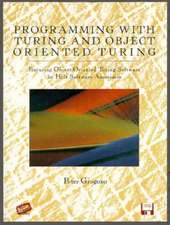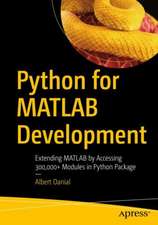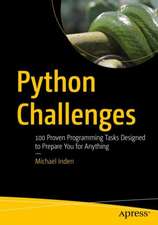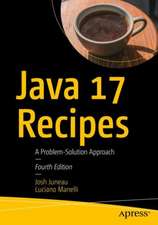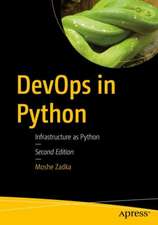Eloquent Ruby: Addison-Wesley Professional Ruby
Autor Russ Olsenen Limba Engleză Paperback – 31 mar 2011
Olsen draws on years of experience internalizing the Ruby culture and teaching Ruby to other programmers. He guides you to the "Ah Ha!" moments when it suddenly becomes clear why Ruby works the way it does and how you can take advantage of its unique approach.
Eloquent Ruby starts small, answering tactical questions focused on a single statement, method, test, or bug. You'll learn how to write code that actually looks like Ruby (not Java); why Ruby has so many control structures; how to use strings, expressions, and symbols; and what dynamic typing is really good for.
Next, Olsen turns to bigger questions related to building methods and classes. You'll discover why Ruby classes contain so many tiny methods, when to use operator overloading, and when to avoid it. Olsen explains how to write Ruby code that writes its own code-and why you'll want to. He concludes with powerful project-level features and techniques ranging from gems to Domain Specific Languages.
The newest book in the renowned Addison-Wesley Professional Ruby Series, Eloquent Ruby will help you "put on your Ruby-colored glasses" and get results that make you a true believer.
Preț: 264.08 lei
Preț vechi: 330.09 lei
-20% Nou
50.53€ • 52.90$ • 41.81£
Carte disponibilă
Livrare economică 15-29 martie
Livrare express 01-07 martie pentru 39.43 lei
Specificații
ISBN-10: 0321584104
Pagini: 413
Dimensiuni: 175 x 229 x 25 mm
Greutate: 0.68 kg
Ediția:1
Editura: Addison-Wesley Professional
Seria Addison-Wesley Professional Ruby
Locul publicării:Boston, United States
Notă biografică
Cuprins
Foreword xix
Preface xxi
Acknowledgments xxv
About the Author xxvii
PART I: The Basics 1
Chapter 1: Write Code That Looks Like Ruby 3
The Very Basic Basics 4
Go Easy on the Comments 6
Camels for Classes, Snakes Everywhere Else 8
Parentheses Are Optional but Are Occasionally Forbidden 9
Folding Up Those Lines 10
Folding Up Those Code Blocks 11
Staying Out of Trouble 12
In the Wild 13
Wrapping Up 15
Chapter 2: Choose the Right Control Structure 17
If, Unless, While, and Until 17
Use the Modifier Forms Where Appropriate 19
Use each, Not for 20
A Case of Programming Logic 21
Staying Out of Trouble 23
In the Wild 25
Wrapping Up 27
Chapter 3: Take Advantage of Ruby's Smart Collections 29
Literal Shortcuts 29
Instant Arrays and Hashes from Method Calls 30
Running Through Your Collection 33
Beware the Bang! 36
Rely on the Order of Your Hashes 38
In the Wild 38
Staying Out of Trouble 40
Wrapping Up 42
Chapter 4: Take Advantage of Ruby's Smart Strings 43
Coming Up with a String 44
Another API to Master 47
The String: A Place for Your Lines, Characters, and Bytes 49
In the Wild 50
Staying Out of Trouble 51
Wrapping Up 52
Chapter 5: Find the Right String with Regular Expressions 53
Matching One Character at a Time 54
Sets, Ranges, and Alternatives 55
The Regular Expression Star 57
Regular Expressions in Ruby 58
Beginnings and Endings 60
In the Wild 62
Staying Out of Trouble 63
Wrapping Up 64
Chapter 6: Use Symbols to Stand for Something 65
The Two Faces of Strings 65
Not Quite a String 66
Optimized to Stand for Something 67
In the Wild 69
Staying Out of Trouble 70
Wrapping Up 71
Chapter 7: Treat Everything Like an Object-Because Everything Is 73
A Quick Review of Classes, Instances, and Methods 74
Objects All the Way Down 76
The Importance of Being an Object 77
Public, Private, and Protected 79
In the Wild 81
Staying Out of Trouble 82
Wrapping Up 84
Chapter 8: Embrace Dynamic Typing 85
Shorter Programs, But Not the Way You Think 85
Extreme Decoupling 89
Required Ceremony Versus Programmer-Driven Clarity 92
Staying Out of Trouble 93
In the Wild 94
Wrapping Up 96
Chapter 9: Write Specs! 97
Test::Unit: When Your Documents Just Have to Work 98
A Plethora of Assertions 101
Don't Test It, Spec It! 101
A Tidy Spec Is a Readable Spec 104
Easy Stubs 105
. . . And Easy Mocks 107
In the Wild 108
Staying Out of Trouble 110
Wrapping Up 113
PART II: Classes, Modules, and Blocks 115
Chapter 10: Construct Your Classes from Short, Focused Methods 117
Compressing Specifications 117
Composing Methods for Humans 121
Composing Ruby Methods 122
One Way Out? 123
Staying Out of Trouble 126
In the Wild 127
Wrapping Up 128
Chapter 11: Define Operators Respectfully 129
Defining Operators in Ruby 129
A Sampling of Operators 131
Operating Across Classes 134
Staying Out of Trouble 135
In the Wild 137
Wrapping Up 139
Chapter 12: Create Classes That Understand Equality 141
An Identifier for Your Documents 141
An Embarrassment of Equality 142
Double Equals for Everyday Use 143
Broadening the Appeal of the == Method 145
Well-Behaved Equality 146
Triple Equals for Case Statements 149
Hash Tables and the eql? Method 150
Building a Well-Behaved Hash Key 152
Staying Out of Trouble 153
In the Wild 154
Wrapping Up 156
Chapter 13: Get the Behavior You Need with Singleton and Class Methods 157
A Stubby Puzzle 158
A Hidden, but Real Class 160
Class Methods: Singletons in Plain Sight 162
In the Wild 164
Staying Out of Trouble 165
Wrapping Up 167
Chapter 14: Use Class Instance Variables 169
A Quick Review of Class Variables 169
Wandering Variables 171
Getting Control of the Data in Your Class 174
Class Instance Variables and Subclasses 175
Adding Some Convenience to Your Class Instance Variables 176
In the Wild 177
Staying Out of Trouble 179
Wrapping Up 179
Chapter 15: Use Modules as Name Spaces 181
A Place for Your Stuff, with a Name 181
A Home for Those Utility Methods 184
Building Modules a Little at a Time 185
Treat Modules Like the Objects That They Are 186
Staying Out of Trouble 189
In the Wild 190
Wrapping Up 191
Chapter 16: Use Modules as Mixins 193
Better Books with Modules 193
Mixin Modules to the Rescue 195
Extending a Module 197
Staying Out of Trouble 198
In the Wild 202
Wrapping Up 205
Chapter 17: Use Blocks to Iterate 207
A Quick Review of Code Blocks 207
One Word after Another 209
As Many Iterators as You Like 210
Iterating over the Ethereal 211
Enumerable: Your Iterator on Steroids 213
Staying Out of Trouble 215
In the Wild 217
Wrapping Up 218
Chapter 18: Execute Around with a Block 219
Add a Little Logging 219
When It Absolutely Must Happen 224
Setting Up Objects with an Initialization Block 225
Dragging Your Scope along with the Block 225
Carrying the Answers Back 227
Staying Out of Trouble 228
In the Wild 229
Wrapping Up 231
Chapter 19: Save Blocks to Execute Later 233
Explicit Blocks 233
The Call Back Problem 234
Banking Blocks 236
Saving Code Blocks for Lazy Initialization 237
Instant Block Objects 239
Staying Out of Trouble 240
In the Wild 243
Wrapping Up 244
PART III: Metaprogramming 247
Chapter 20: Use Hooks to Keep Your Program Informed 249
Waking Up to a New Subclass 250
Modules Want To Be Heard Too 253
Knowing When Your Time Is Up 255
. . . And a Cast of Thousands 256
Staying Out of Trouble 257
In the Wild 259
Wrapping Up 261
Chapter 21: Use method_missing for Flexible Error Handling 263
Meeting Those Missing Methods 264
Handling Document Errors 266
Coping with Constants 267
In the Wild 268
Staying Out of Trouble 270
Wrapping Up 271
Chapter 22: Use method_missing for Delegation 273
The Promise and Pain of Delegation 274
The Trouble with Old-Fashioned Delegation 275
The method_missing Method to the Rescue 277
More Discriminating Delegation 278
Staying Out of Trouble 279
In the Wild 281
Wrapping Up 283
Chapter 23: Use method_missing to Build Flexible APIs 285
Building Form Letters One Word at a Time 286
Magic Methods from method_missing 287
It's the Users That Count-All of Them 289
Staying Out of Trouble 289
In the Wild 290
Wrapping Up 292
Chapter 24: Update Existing Classes with Monkey Patching 293
Wide-Open Classes 294
Fixing a Broken Class 295
Improving Existing Classes 296
Renaming Methods with alias_method 297
Do Anything to Any Class, Anytime 299
In the Wild 299
Staying Out of Trouble 303
Wrapping Up 303
Chapter 25: Create Self-Modifying Classes 305
Open Classes, Again 305
Put Programming Logic in Your Classes 308
Class Methods That Change Their Class 309
In the Wild 310
Staying Out of Trouble 314
Wrapping Up 315
Chapter 26: Create Classes That Modify Their Subclasses 317
A Document of Paragraphs 317
Subclassing Is (Sometimes) Hard to Do 319
Class Methods That Build Instance Methods 321
Better Method Creation with define_method 324
The Modification Sky Is the Limit 324
In the Wild 327
Staying Out of Trouble 330
Wrapping Up 332
PART IV: Pulling It All Together 333
Chapter 27: Invent Internal DSLs 335
Little Languages for Big Problems 335
Dealing with XML 336
Stepping Over the DSL Line 341
Pulling Out All the Stops 344
In the Wild 345
Staying Out of Trouble 347
Wrapping Up 349
Chapter 28: Build External DSLs for Flexible Syntax 351
The Trouble with the Ripper 352
Internal Is Not the Only DSL 353
Regular Expressions for Heavier Parsing 356
Treetop for Really Big Jobs 358
Staying Out of Trouble 360
In the Wild 362
Wrapping Up 364
Chapter 29: Package Your Programs as Gems 367
Consuming Gems 367
Gem Versions 368
The Nuts and Bolts of Gems 369
Building a Gem 370
Uploading Your Gem to a Repository 374
Automating Gem Creation 375
In the Wild 376
Staying Out of Trouble 377
Wrapping Up 380
Chapter 30: Know Your Ruby Implementation 381
A Fistful of Rubies 381
MRI: An Enlightening Experience for the C Programmer 382
YARV: MRI with a Byte Code Turbocharger 385
JRuby: Bending the "J" in the JVM 387
Rubinius 388
In the Wild 389
Staying Out of Trouble 389
Wrapping Up 390
Chapter 31: Keep an Open Mind to Go with Those Open Classes 391
Appendix: Going Further 393
Index 397

